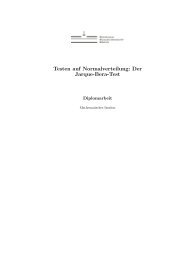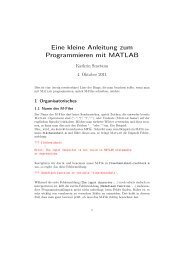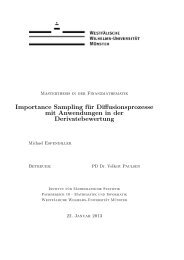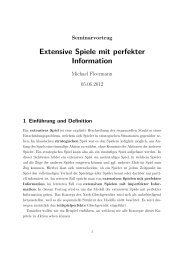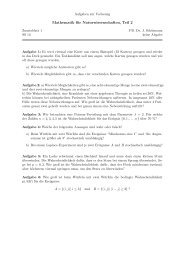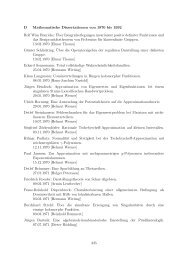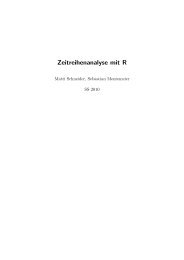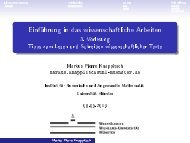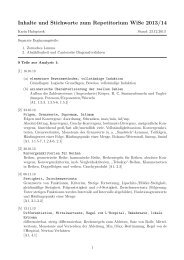Margulis Lemma
Margulis Lemma
Margulis Lemma
You also want an ePaper? Increase the reach of your titles
YUMPU automatically turns print PDFs into web optimized ePapers that Google loves.
STRUCTURE OF FUNDAMENTAL GROUPS 19<br />
Covering <strong>Lemma</strong> (1.6) we have<br />
∫ 1<br />
0<br />
Mx(‖∇· ˜Xt i ‖ α ) 1/α (˜c i (t)) dt ≤ C<br />
∫ 1<br />
0<br />
Mx(‖∇·X t i ‖ α ) 1/α (c i (t)) dt<br />
with some universal constant C. Thus ˜φ i1 : (λ i ˜Mi , ˜p i ) → (λ i ˜Mi , φ i1 (˜p i )) has the<br />
zooming in property as well. Any other lift ˜f i of f i is obtained by composing ˜φ i1<br />
with a deck transformation and thus the result carries over to any lift of f i .<br />
□<br />
Proposition 3.8 (Second main example). Let (M i , g i ) be a sequence of manifolds<br />
with Ric > −1/i on B i (p i ) and B i (p i ) compact. Suppose that (M i , p i ) converges to<br />
(R k × Y, p ∞ ).<br />
Then for each v ∈ R k there is a sequence of diffeomorphisms f i : [M i , p i ] →<br />
[M i , p i ] with the zooming in property which converges in the weakly measured sense<br />
to an isometry f ∞ of R k × Y that acts trivially on Y and by w ↦→ w + v on R k .<br />
Moreover, f i is isotopic to the identity and there is a lift ˜f i : [ ˜M i , ˜p i ] → [ ˜M i , ˜p i ] of<br />
f i to the universal cover which has the zooming in property as well.<br />
Proof. Using the splitting R k = Rv ⊕(v) ⊥ and replacing Y by Y ×(v) ⊥ we see that<br />
it suffices to prove the statement for k = 1.<br />
By the work of Cheeger and Colding [CC96] we can find sequences ρ i → ∞ and<br />
ε i → 0 and harmonic functions b i : B 4ρi (p i ) → R such that<br />
|∇b i | ≤ L(n) for all i and<br />
∫<br />
(∣<br />
− ∣|∇bi | − 1 ∣ + ‖Hessbi ‖ ) 2<br />
≤ ε i for any R ∈ [1/4, 4ρ i ].<br />
B 4R (p i)<br />
Let X i be a vector field with compact support with X i = ∇b i on B 3ρi (p i ), and<br />
let φ it denote the flow of X i . Clearly for any t we can find r i → ∞ such that<br />
φ it|Bri (p i) is measure preserving.<br />
Put ψ i := ∣ ∣|∇b i | − 1 ∣ + ‖Hess(b i )‖. We deduce from <strong>Lemma</strong> 1.4 that<br />
∫<br />
− Mx(ψ i ) 2 ≤ C(n, R)ε i<br />
and Cauchy Schwarz gives<br />
∫<br />
−<br />
B 2R (p i)<br />
B R (p i)<br />
Mx(ψ i ) ≤ √ C(n, R)ε i .<br />
Suppose now that t 0 ≤ R<br />
4L(n) . Then φ t(q) ∈ B 3R (p i ) for all q ∈ B<br />
4<br />
R/2 (p i )<br />
and all t ∈ [−t 0 , t 0 ]. Combining that φ t is measure preserving and vol(B R (p i )) ≤<br />
C 3 vol(B R/2 (p i )), we get that<br />
∫ ∫ t0<br />
∫<br />
−<br />
Mx(ψ i )(φ t (p)) ≤ C 3 t 0 − Mx(ψ)<br />
B R/2 (p i)<br />
0<br />
It is now easy to find R i → ∞ and δ i → 0 with<br />
B R (p i)<br />
≤ C 4 (t 0 , R, n) √ ε i .<br />
∫ ∫ t0<br />
− Mx(ψ i )(φ t (p)) ≤ δ i for all R ∈ [1, R i ].<br />
B R (p i) 0



